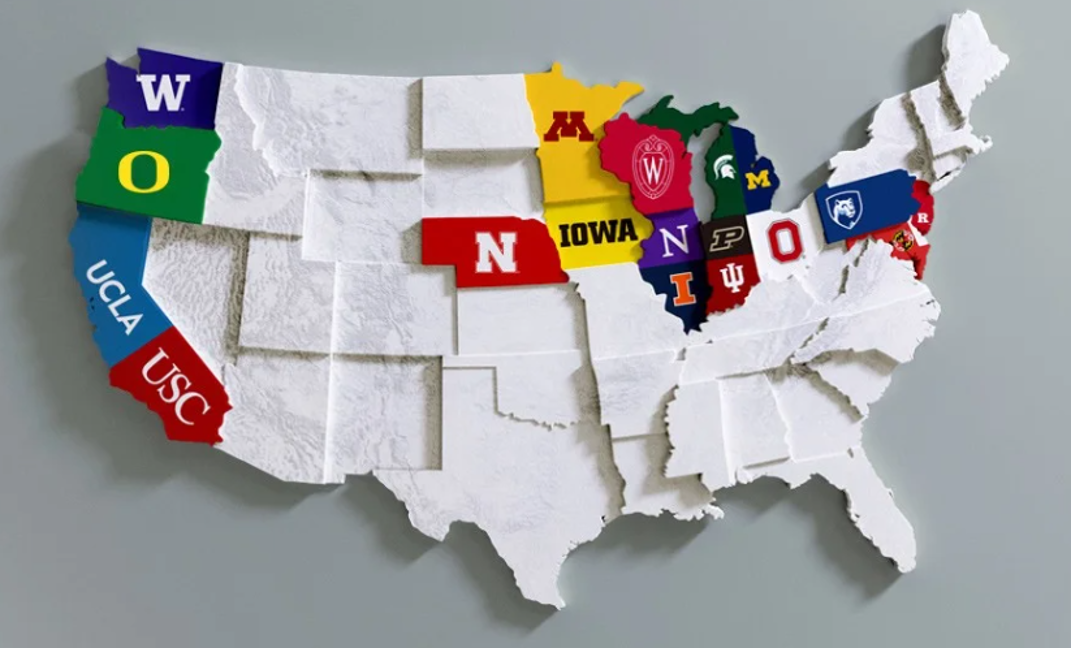For the first time in thirteen years, additions were made to the Big Ten Conference. The last schools to join were Penn State in 1990, then Rutgers and Maryland in 2011. In August, four more teams were added to the conference, including The University of California Los Angeles, The University of Southern California, The University of Washington, and The University of Oregon. So, why did these four teams leave the Pac-12 and join the B1G Ten?
Starting with UCLA, the university was founded in 1919, and before they moved to the Big 10, they were in the Pac 12. According to Newsroom UCLA, Athletic Director, Martin Jarmond of UCLA said, “The university, along with former Pac-12 Conference rivals USC, Oregon, and Washington, joins the nation’s oldest NCAA Division I athletic conference as part of the biggest coast-to-coast conference realignment in college sports.” UCLA’s impending move was announced two years ago during major shifts in college sports. With this new conference, brings new competitive opportunities and a broader national recognition for the UCLA student-athletes to show off their talents, along with better facilities and resources to support athletic and academic programs. AD Jarmond said, “The day has finally come. After two years of planning and preparation, UCLA is proud and excited to join the Big Ten Conference. I am grateful for the energy and effort that has been put into shaping this pivotal move by our hard-working staff members, as well as our coaches and student-athletes. The investments we have made into our programs and student-athletes over the past 24 months have set us up to continue to compete at the elite level that defines UCLA Athletics.” Overall this move benefits UCLA and the Big Ten due to their already massive branding.
Second, former PAC 12 rival, USC will continue to play the Victory Bell Rivalry game against UCLA, even though the schools have changed conferences. According to USC Today, university president, Carol Folt, said, “This is the dawn of a new era for USC Athletics. At this critical moment when there are seismic changes coming across the athletics landscape, it was fortuitous that we made this commitment two years ago. We are prepared, and we are ready. We are well-positioned to compete with the best student-athletes far into the future.” The move was led by Folt, to bring more opportunities to the entire university and greatly increase their profile on a national stage. USC’s student-athletes will see many benefits to this move, with additional exposure and resources at hand. Employees of the university will benefit from the academic prowess of the Big Ten. USC was already a highly intelligent school that fit the Big Ten picture perfectly.
Third, Washington University was founded in 1853 and former Pac 12 member.UW President, Ana Mari Cauce, announced Friday, “The University of Washington will join the Big Ten Conference, leaving the Pac-12 Conference, effective in August 2024. We have tremendous respect for the Pac-12, its treasured history and traditions,” Jen Cohen, the UW’s AD said, “At the same time, the college athletics landscape has changed dramatically in recent years. The Big Ten’s history of athletic and academic success and long-term stability best positions our teams for future success, and we are energized at the opportunity to compete at the highest level against some of the best programs in the country.” This is the third school that has talked about the same thing, they are moving conferences to give their student-athletes better opportunities and resources.
And lastly, The University of Oregon was founded in 1872, and just like the last three schools, made the move to the Big Ten from the Pac 12. This is the message to the fans from Athletic Director, Rob Mullens, “Our membership in the Big Ten Conference opens a new chapter for Oregon Athletics filled with boundless opportunities and potential. Our student-athletes will now have the chance to compete against the best of the best, and they will be exposed to a broader audience that can create new opportunities for them.” Athletics is not the only reason Oregon joined the Big Ten, “We are eager to team up with clinical and scientific researchers at Big Ten member institutions to attack our common enemy.” said Bob Guldberg, the university Vice President. The Big Ten has a very good Cancer Research Program that provides powerful opportunities for students to drive new scientific discoveries.
All four colleges had one reason in common that they joined, the Big Ten has many athletic powerhouses and many academic resources the Pac-12 might not have had. The leaders of the universities wanted a better environment for their student-athletes and thought they would gain that by joining the Big Ten.














